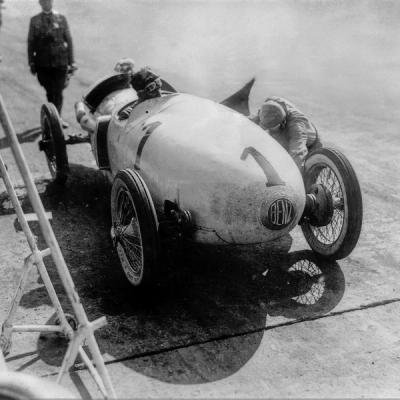Benz RH 2-litre “teardrop” racing car: Mid-engine racing premiere in futuristic form
First mid-engined racing car in history 100 years ago - Important pioneer of modern automotive aerodynamics - Premiere of the independent rear suspension with double-jointed swing axle in racing - Motorsport debut on 9 September 1923 in Monza at the European Grand Prix.
Stuttgart. It was not the winning car that caused a sensation at the European Grand Prix 100 years ago – it was the Benz RH 2-litre “teardrop” racing cars finishing in 4th and 5th place. The abbreviation stands for “racing car rear”. The designs, which seemed futuristic to the public at the time, made their competition debut in the race on 9 September 1923 in Monza, Italy. These first mid- engined racing cars in automotive history were at the same time consistently aerodynamically optimised according to the state of the art at the time. This distinguished them fundamentally from conventional competition vehicles of the era. Ferdinando Minoia (start number 1) finished in 4th place with one of the new racing cars, followed by his teammate Franz Hörner (start number 7) in 5th position. A third Benz RH 2-litre “teardrop” racing car with Willy Walb (starting number 13) dropped out. The race was won by Carlo Salamo in a Fiat. Probably the most important award for Benz & Cie. was not given to a racing driver 100 years ago, but to Max Wagner: the designer of the Mannheim-based manufacturer received an honorary award for the pioneering development of the “teardrop” racing car. In doing so, the organisers of the European Grand Prix paid tribute to the relevance of this Benz vehicle as a game changer in racing car technology.
The prehistory of the Benz RH 2-litre “teardrop” racing car began two years earlier at the German Motor Show in Berlin (23 September to 2 October 1921). There, Dr Hans Nibel, head of development at Benz & Cie, and his designer Max Wagner were impressed by Edmund Rumpler’s “teardrop” car. With a mid-engine and a teardrop-shaped body aerodynamically optimised in the wind tunnel, this passenger car was technically groundbreaking, although it failed to achieve market success. Nibel and Wagner recognised the potential for the development of new vehicles: Benz concluded a licence agreement with Rumpler and received an open “teardrop” car including associated drawing sets. The company continued to develop the design. Motorsport was a testing ground for the new vehicle concept: in 1922, four “teardrop” racing cars were built. And yet another first: at the rear, a double- jointed swing axle guided the wheels.
It was powered by a 66 kW (90 hp) in-line six-cylinder engine developed by Dr Arthur Berger with a displacement of 1,997 cubic centimetres and two overhead camshafts. Its design corresponded to that of the Benz Kaiserpreis aircraft engine of 1912. Also advanced were two Zenith horizontal carburettors and a crankshaft with seven roller bearings. Longitudinal and crossmembers of the frame, pedals, steering wheel spokes, gearshift lever and front axle received numerous weight- reducing holes. After the merger of Benz & Cie. with DMG to form Daimler-Benz AG with the Mercedes-Benz brand in 1926, this feature of consistent lightweight construction could be found, among others, in the SSKL compressor sports car, for whose chassis Max Wagner was also responsible.
For the observer, the exterior of the Benz racing car differed from traditional vehicle designs not only by its streamlined shape and central engine placement, but also by the radiator, among other things. This was curved and sat behind the cockpit on the body. On top, like a sculpture of speed, a teardrop-shaped vessel is enthroned. For the first race at the European Grand Prix in Monza on 9 September 1923, the cars were fitted with a smaller additional radiator to the right of the cockpit. From racing car to sports car After the sensational premiere at the 1923 European Grand Prix in Monza, the Benz “teardrop” racing cars started in further competitions in the following year. The innovative vehicles did not win – because, as they were being developed, the supercharged engine had begun its triumphant march in other vehicles. For example, at the competing Daimler-Motoren-Gesellschaft (DMG) and in their Mercedes 2-litre supercharged racing car, designed by development director Ferdinand Porsche. This vehicle was considerably more powerful and faster, with 93 kW (126 hp) from a displacement of 1,989 cubic centimetres. Benz lacked the financial strength to further develop the pioneering “teardrop” racing car with a supercharged engine but stayed on the case: at the end of 1924, the company developed a sports car that had no special designation. It had a distinctly different body. Among other things, the designers integrated two headlamps, moved the tank from the front to the rear and added splash guards. The works racing driver Willy Walb and the private drivers Adolf Rosenberger and Carl Hermann Tilger became successful drivers with it.
After the merger of Benz & Cie. and Daimler-Motoren-Gesellschaft in 1926 to form Daimler-Benz AG, Porsche did not continue to promote work on the “teardrop” racing cars there. However, he pursued similar concepts at Auto Union after leaving in 1928. Their mid-engined racing cars with sixteen- cylinder engines were the fiercest competitors of the Mercedes-Benz Silver Arrows from 1934. Mercedes-Benz racing driver Rudolf Caracciola won the European Championship title in 1935, 1937 and 1938, comparable in terms of international standing to the World Championship titles of the later Formula One. His teammate Hermann Lang became European champion in 1939. Only in 1936 did the championship go to Auto Union driver Bernd Rosemeyer. In 1934, the European championship title was not yet awarded. The principle of mid-engine racing cars made its debut in Formula One at the end of the 1950s. Press photos and further press releases: media.mercedes-benz.com/content/classic Further research and multimedia material: mercedes-benz-archive.com/museum









